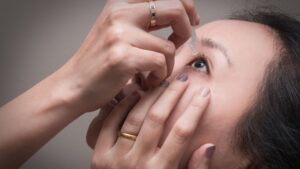Dealing With Dry Eyes | Meibomian Gland Dysfunction
Dry eyes can be a frustrating and uncomfortable condition that affects millions of people worldwide. One common cause of dry eyes is meibomian gland dysfunction (MGD), a condition that affects the function of the meibomian glands located in the eyelids. MGD occurs when these glands become blocked or fail to produce enough oil, leading to an evaporative dry eye. If you suffer from dry eyes caused by MGD, there are several effective treatment options available to alleviate your symptoms and improve your eye health.
1. Warm Compresses and Lid Massages:
One of the simplest and most effective ways to treat meibomian gland dysfunction is through warm compresses and lid massages. Applying a warm compress to your closed eyelids for around 10 minutes helps to soften the blocked oil in your glands, making it easier to express. Afterward, gently massaging your eyelids in a circular motion can help further express the oil and unclog the blocked glands. It is important to ensure that the compress is warm, not hot, to avoid any damage to your eyes.
2. Artificial Tears and Lubricating Eye Drops:
Using lubricating eye drops or artificial tears can provide temporary relief from dry eyes caused by MGD. These drops help to replenish the moisture in your eyes and provide soothing relief. However, it is important to choose eye drops that are specifically formulated for dry eyes and do not contain preservatives, as preservatives can further irritate your eyes. Additionally, avoid eye drops that claim to get the red out as these may contain vasoconstrictors that can worsen dry eye symptoms in the long run.
3. Omega-3 Fatty Acid Supplements:
Research suggests that omega-3 fatty acids, found in fish oil and certain plant-based sources, can help improve meibomian gland function and reduce dry eye symptoms. These supplements work by reducing inflammation and promoting the production of high-quality oil in the glands. It is recommended to consult with your eye doctor before starting any supplements to ensure the appropriate dosage for your specific needs.
4. Prescription Medications:
For more severe cases of meibomian gland dysfunction, your eye doctor may prescribe medications to help alleviate your symptoms. These medications can include topical antibiotics, which can help reduce inflammation and prevent bacterial growth in the glands. Anti-inflammatory medications, such as corticosteroids, may also be prescribed in certain cases. However, long-term use of corticosteroids should be carefully monitored to prevent potential side effects.
5. In-Office Treatments:
In addition to at-home remedies, there are several in-office treatments available to help manage meibomian gland dysfunction. These treatments are usually performed by an eye care professional and provide more targeted and intensive relief for the condition. Some common in-office treatments include:
– Meibomian gland expression:
Your eye doctor may use special instruments to manually express the oil from your meibomian glands. This technique helps to clear any blockages and improve oil flow.
– Intense Pulsed Light (IPL) therapy:
IPL therapy uses light energy to heat and liquefy the blocked oil, improving the flow from the meibomian glands. This treatment also helps reduce inflammation and can be an effective option for MGD sufferers.
– LipiFlow:
LipiFlow is an FDA-approved treatment that combines warmth and gentle pressure to unclog the blocked glands and promote healthy oil production. This treatment is typically performed in-office and can provide long-lasting relief for dry eye symptoms caused by MGD.
6. Eyelid Hygiene:
Proper eyelid hygiene is crucial for managing meibomian gland dysfunction. Regularly cleaning your eyelids and lashes helps to remove debris, bacteria, and excess oil that can contribute to blocked glands. To clean your eyelids, use a gentle cleanser recommended by your eye doctor or simply a mixture of warm water and baby shampoo. Gently scrub the base of your eyelashes using a clean cotton swab or clean fingertip. Avoid rubbing your eyes vigorously as this can further irritate the glands and worsen symptoms.
7. Environmental Modifications:
Making a few changes to your environment can also help reduce dry eye symptoms caused by MGD. Consider using a humidifier in your home, especially in the winter months when indoor air tends to be dry due to heating systems. Avoid sitting directly in front of fans or air conditioning units that can blow dry air into your face. Additionally, wearing wrap-around sunglasses can protect your eyes from wind and other environmental factors that can exacerbate dry eye symptoms.
8. Regular Eye Exams:
Regular eye exams are essential for monitoring and managing meibomian gland dysfunction. Your eye doctor can assess your condition, determine the severity of your MGD, and recommend suitable treatment options. They can also provide guidance on proper eye care practices tailored to your specific needs.
Conclusion:
In conclusion, meibomian gland dysfunction can be a challenging condition to manage, but with a combination of at-home remedies, medication, and in-office treatments, you can find relief from your dry eye symptoms. Remember to consult with your eye doctor to determine the best treatment plan for your specific needs. With proper care and management, you can improve your eye health and enjoy long-lasting relief from dry eyes.
















